
views
Hanging Thyme to Dry It
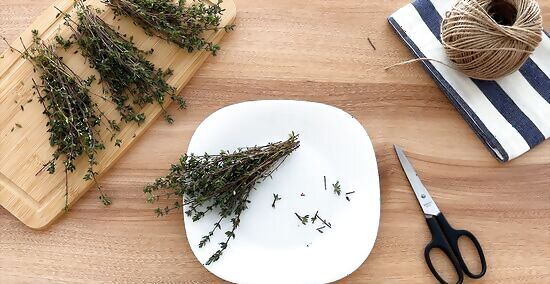
Gather sprigs of fresh thyme. Pick long stems of new growth from your plant. Use a sharp pair of scissors or pruners and trim right above the woody sections of the plant. You’re looking for sprigs that are strong and will stay together as they dry. You can trim most of the new growth off of a plant as long as you keep the woody growth intact. It’s best to pick sprigs that have not bloomed. Instead, choose young, fresh sprigs throughout the spring and summer.

Rinse and dry the sprigs. Wash the thyme by running it under cool water. The goal should be to rinse away any dirt or grime that might have gotten on the leaves as they grew. Once the sprigs are rinsed, lay them on a clean towel until they don't have any moisture on their surface. Making sure that the thyme no longer was water on it will minimize the chance of it getting moldy as it dries.

Gather the sprigs into a bundle. Pick up each sprig of thyme and hold it by the thick end that you cut. Place all these ends together into a bundle and gather them together tightly. If you have more thyme than can fit into a bundle with a diameter of 1 inch (2.5 cm), then make several bundles.

Tie your bundle together. Hold your bundle in your less dominant hand and have a piece of string or twine that is about 12 inches (30 cm) long in the other hand. Start wrapping the string around the bundle, leaving a few inches loose before the start of the wraps. Once the bundle is secure and you have a few inches of string left at the end, tie the end to the piece you left loose at the beginning. You can tie the ends together with a bow or a knot but just make sure that it is tight and secure.
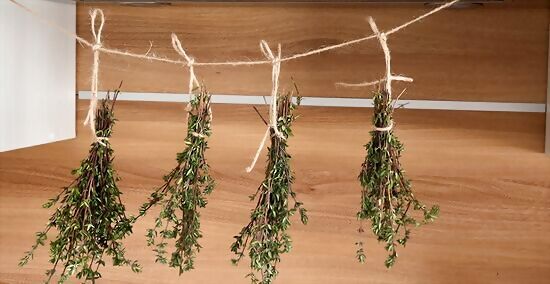
Hang the bundle in a warm, dark place. Loop the string on a nail or a hook in a spot that will let the bundle hang freely. You want free airflow around the bundle and you want it to be out of direct sunlight, which could dry the thyme too quickly. The temperature around the thyme should be at least 50 °F (10 °C). This temperature will ensure that the thyme dries at a steady rate. It’s best to have the thyme in a spot with low humidity, so that mold doesn’t develop on it. Check the thyme for mold after the first few days of drying. Throw it out if you see any on the sprigs. However, after the first few days the risk of mold developing is minimal because the plant will have lost most of its moisture. You can hang your thyme to dry in any dark corner of your kitchen, living room, or dining room, as long as it has good air flow and a warm temperature.

Pull off the leaves when the thyme is completely dry. Once the thyme looks and feels dry, you can take the bundle down and process it. Place the bundle on a clean sheet pan or a piece of wax paper and open it up. Start removing the leaves by plucking them off the stems with your fingers. They should come off relatively easily once the thyme is dry. The amount of time it will take for your thyme to dry will vary depending on the variety of your thyme and the conditions you are growing it in. However, it usually takes 1 or 2 weeks for thyme to dry out completely. An easy way to do this is to hold the stem in one hand and run your fingers down the stem with your other hand.
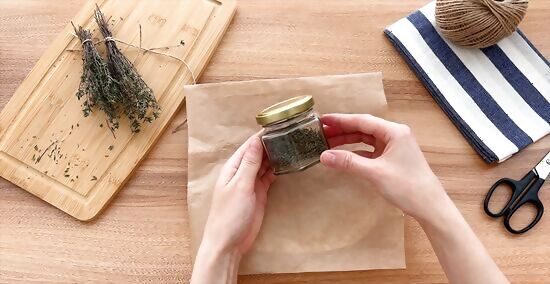
Store the thyme in an air-tight container in a dark place. Keeping it in an air-tight container and keeping it out of sunlight can keep it fresh and tasty for several years after drying. Many people put it in spice jars but you can also simply put it in an air-tight plastic bag or mason jar with a lid. Put the container in a dark, dry location, such as a cupboard or pantry. The thyme will basically never go "bad" but it will lose its flavor potency over time. After a year or so you should assess the flavor your dried thyme has and decide if you need to dry some more.
Drying Thyme in an Oven
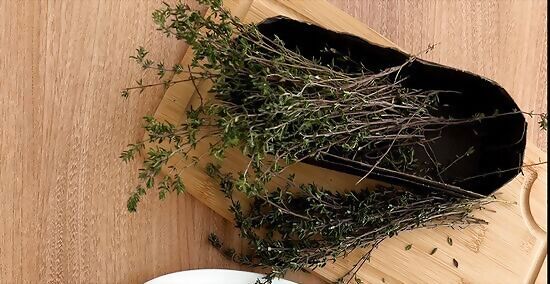
Pick fresh thyme from your garden. Use a sharp pair of scissors or pruners to trim sprigs without blooms right above the hard wood of the plant. It’s quickest to pick long stems with lots of leaves on them but you can dry small pieces in the oven as well. Trimming most of the new growth off the plant is fine, as long as you keep the woody parts intact. In fact, this will encourage your plant to grow. If you have fresh thyme that you have bought from a grocery store, you can still dry it. It just won’t be as fresh, so it might have less flavor once dried.

Wash your thyme with cold water. Rinse the leaves under cold water, which will remove any dirt or residue that is on its surface. Use a light stream of water so that the leaves stay on the sprigs you are cleaning. Once you have rinsed the thyme, give it a light shake to remove most of the water off the surface of it. However, the thyme does not need to be completely dry before moving on with the process.
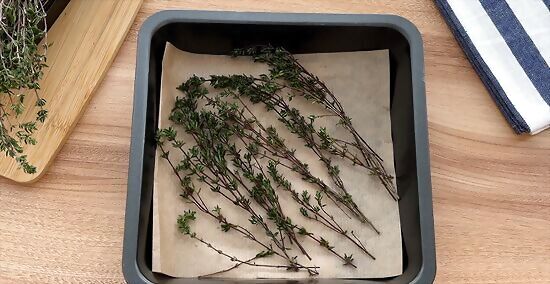
Lay out the thyme on a pan lined with parchment or a silicone mat. Get out a sheet pan that is big enough to lay out the thyme in a single layer. Line it with parchment or a silicone mat so that the thyme is not in contact with metal. Make sure that the sprigs are not lying on top of each other so that they all dry at the same pace. If the thyme is in direct contact with metal, it can turn black or lose its bright color.
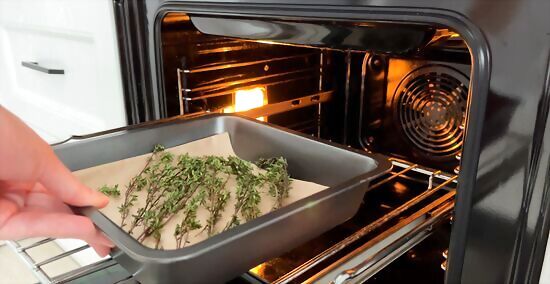
Dry the thyme in an oven that is heated to 100 °F (38 °C) for 24 hours. Place the pan on the center rack of the oven after it has preheated. To get the oven to 100 °F (38 °C), you can either set it to that temperature, turn on the light inside (which can usually heat up the oven that much), or rely on the heat from the pilot in a gas oven. It’s best to dry thyme at a moderate heat for a long time. This allows the leaves to dry out without getting cooked or wilting first. Take a look at the leaves every few hours as they dry. Make sure they are not burning and that they seem to be wilting and then drying.

Pull the leaves off the thyme once it comes to room temperature. Pull the pan out of the oven and let it come to room temperature. Make sure the thyme is totally dry by pulling a few leaves off the stems and feeling that they are brittle. Once you have ensured that the thyme is dry, you can pull the rest of the leaves off the stems. Once off the stems, store the leaves in an air-tight container in a dark, cool location. This will keep your dried thyme fresh for 1 to 2 years.
Using a Dehydrator to Dry Thyme
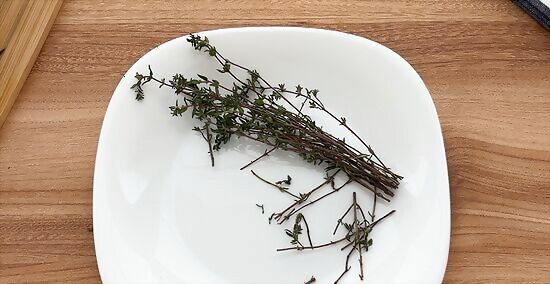
Cut fresh thyme sprigs from your thyme plant. Use sharp pruners or scissors to harvest from your thyme plant. Focus on trimming off solid young sprigs that don’t have blooms at the end and are not woody and sparse. You can trim as much new growth off the plant as you like. As long as you keep the woody core of the plant intact, your thyme plant will regrow after trimming. Typically, you will have the most to harvest in the spring or summer, although thyme plants can be lightly trimmed at any time of year.
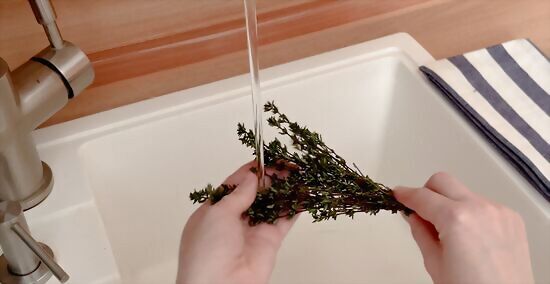
Rinse and dry the thyme. Run the sprigs under a light stream of cool water to remove any impurities from the surface. Then lay them out on a clean kitchen towel or paper towel until they are dry. Making sure the thyme is dry before you put it in the dehydrator will make it easier for the dehydrator to do its work.
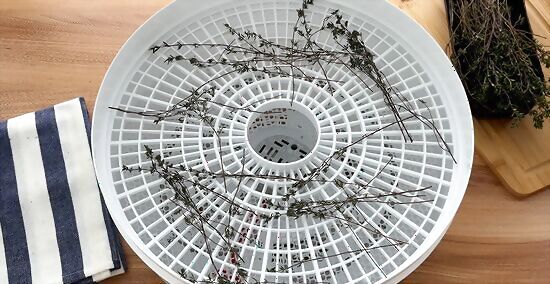
Dry the thyme in your dehydrator at 100 °F (38 °C) for 1 to 2 hours. Place the thyme in your dehydrator trays. Place the trays in the dehydrator and run the machine for several hours. You will know the thyme is done when it looks dry and crumbles easily. Make sure that the bottom of the trays is fine enough to hold the leaves if they fall off the stems. If they are not, you can put fine screen at the bottom of them to hold the leaves.

Take the leaves off the stems and store them in an air-tight container. Pick up the stem and hold it over a bowl or pan that can catch the leaves. Gently run your fingers down the stem to detach the leaves. Discard the stems and put the leaves in an air-tight container, such as a mason jar. Store the jar in a cool, dark, and dry location, such as a pantry. Your dried thyme should last for more than a year if it is stored properly.













Comments
0 comment